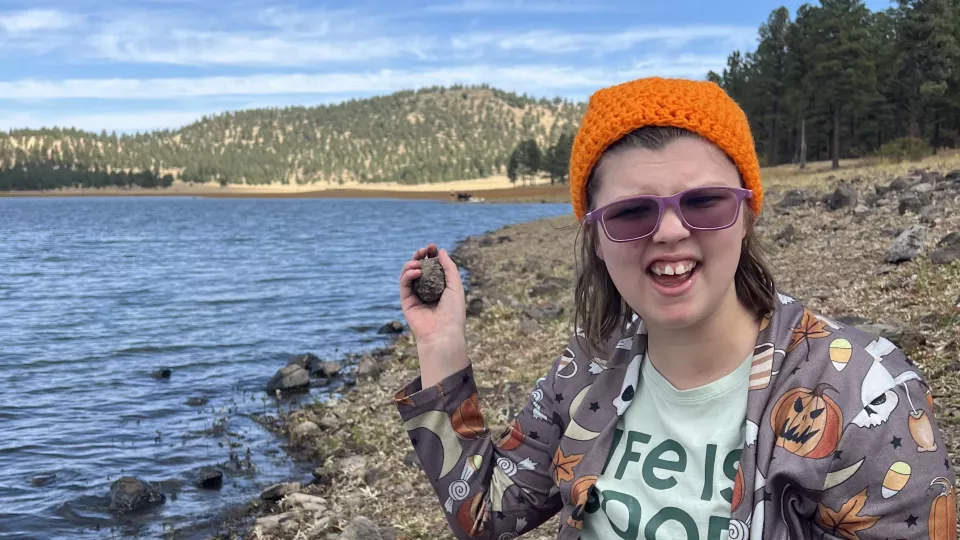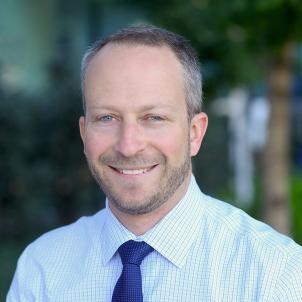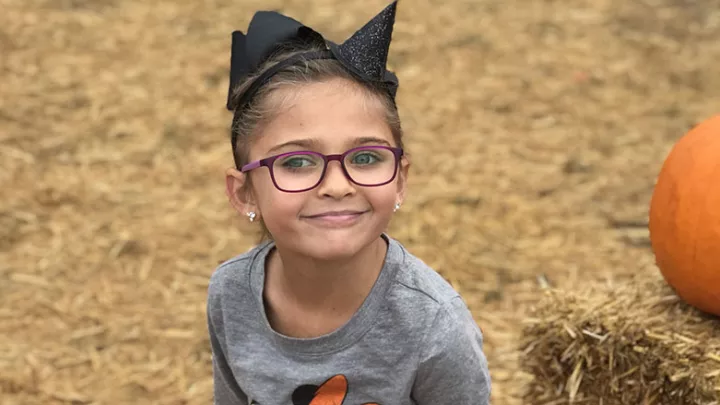
Retinal Gene Therapy Expands Ashlyn’s Visual World
“I can see your eyes!” a then-10-year-old Ashlyn exclaimed to her big sister, Kailey. On a June morning in 2017, the girls sat face-to-face in their Los Angeles hotel room as Ashlyn studied Kailey in detail for the first time: green eyes, long eyelashes, and shiny blonde hair.
“Of course, all of us were sobbing,” recalls Ashlyn’s mom, Christina.

Just a few days earlier, Ashlyn would have been classified as functionally blind. She could make out only very blurry shapes, shadows, and colors in bright light, and she could see next to nothing in the dark.
That year, Ashlyn became one of the first kids at Children’s Hospital Los Angeles—and in the world—to receive a groundbreaking gene therapy called Luxturna. Now a high school sophomore, Ashlyn continues to discover the big and small details of a visual world she couldn't access before.
Vision-restoring gene therapy
Luxturna is a one-time gene therapy for a specific inherited retinal disease that causes blindness.
“Gene therapies represent a method of permanently altering the course of the disease—and the person’s life—through a single procedure,” explains Aaron Nagiel, MD, PhD, a retinal specialist in the Vision Center at CHLA. Dr. Nagiel and his team recently completed their 100th retinal gene therapy procedure, which includes more Luxturna procedures than anywhere else in the country.

The treatment works by delivering a healthy copy of a specific gene, RPE65, into the patient’s retinal cells.
“I often tell patients and their families that the retina is like a factory,” says Dr. Nagiel.
A damaged RPE65 gene means that the retina cannot complete the visual cycle, which is the process that enables sight. “The patient’s ‘factory’ is at a total standstill because one tiny tool is missing.”
Once Luxturna equips the retina with that missing tool—a functional copy of RPE65—the retina can convert light into electrical signals which are interpreted by the brain for sight. “Luxturna can restore vision loss and help children maintain their sight over the course of their lifetime,” adds Dr. Nagiel.
Aaron Nagiel, MD, PhDLuxturna can restore vision loss and help children maintain their sight over the course of their lifetime.
The path to diagnosis
For Christina, eye care is a family affair: She leads a private optometry practice alongside her father in Southern Arizona. Still, Ashlyn’s unique condition caught them by surprise. “Nobody else in our family has had any vision-related conditions,” she says.
As soon as Ashlyn was born, Christina and her dad began to recognize irregularities in Ashlyn’s vision. For example, Christina noted that Ashlyn’s eyes “jiggled,” which can indicate an underlying condition.
“As a medical professional, it was shocking to me how hard it was to get results,” Christina recalls. “We had nearly every ophthalmologist in the city look at Ashlyn’s eyes. Genetic testing didn’t show any irregularities, and each doctor had a different diagnosis—she was diagnosed with 10 different things by the time she was 2, and none of them ended up being what it truly was.”
When Ashlyn turned 9, Christina felt a pull to complete genetic testing one more time. She knew advancements over the past several years might mean that the newer test could unveil additional information.
“My mom instinct was saying, ‘We’re missing something here.’”
Christina’s mom instinct was spot-on: The second round of testing revealed the rare genetic mutation, RPE65, which causes Leber congenital amaurosis (LCA). Present from birth, LCA leads to rapid, severe vision loss, including sensitivity to light and difficulty seeing in low light. In many cases, LCA leads to total blindness by middle age.
New treatment horizons
Christina describes the timing of Ashlyn’s diagnosis as nothing short of miraculous after spending nearly a decade looking for answers. Within six months of finding out Ashlyn had LCA, vision-saving Luxturna would become available to kids with her diagnosis.

Shortly before Christmas 2016, Ashlyn’s ophthalmologist called Christina with news: He explained the freshly approved retinal gene therapy and asked if the family wanted to be on the front lines of this innovation.
“It was a no-brainer,” Christina recalls. “I was like, ‘Yes, we will do that. How do we do that?’ We were ready to do whatever it took.”
Ashlyn’s doctor shared a shortlist of pediatric retinal specialty centers that had begun to administer Luxturna. The family started with a road trip to CHLA. “We met Dr. Nagiel and his team and that's all we needed,” Christina says. “They were all so wonderful, and he had a lot of experience with young children and little eyes. Once we met Dr. Nagiel, we knew he was meant to help our daughter.”
Christina, Ashlyn's momOnce we met Dr. Nagiel, we knew he was meant to help our daughter.
"Trust in the process"
Things moved at lightning speed after that initial call. By May of 2017, the family was on their way from Arizona back to CHLA for Ashlyn’s surgery.
“We didn’t know all the details when we drove up there,” Christina says. “We didn’t even have the insurance authorization yet. We were just going on faith and saying to Ashlyn, ‘We really hope this works out. If it doesn't, we're going to do everything we can to give you the best quality of life possible.’”
“We had a lot of trust in the process,” Christina adds. “That’s a big part of what got us through so seamlessly.”
A trailblazing retinal gene therapy procedure
Most gene therapies can be dosed through an IV infusion in the arm, but Luxturna must be delivered directly into the retina. The procedure is highly complex with many logistical considerations.

First, the medicine itself needs to be kept in a special freezer at minus-112 degrees Fahrenheit. Once the dose is thawed and prepared, it must be used within four hours.
Then, Dr. Nagiel uses his hands, feet, and eyes to prepare the patient’s eye and inserts the gene therapy medication under the retina.
“There weren't many people before Ashlyn who did this procedure, so we didn't know for sure what the long-term outcome was going to be,” Christina says. “But we knew there was a pretty good chance of her vision getting better and staying better. And that's exactly what happened.”
Christina, Ashlyn's momThere weren't many people before Ashlyn who did this procedure, so we didn't know for sure what the long-term outcome was going to be. But we knew there was a pretty good chance of her vision getting better and staying better. And that's exactly what happened.
A challenging recovery
Ashlyn and her family stayed in Los Angeles for more than a month during her treatment and recovery. Dr. Nagiel operated on each eye one week apart to allow the first eye to recover before surgery on the second.

Ashlyn found the extra light sensitivity and loads of new visual stimuli extra challenging at first. She even spent several days retreating to the hotel room closet for sensory breaks.
“It was a really good process, and it was really hard,” Christina recalls. “It was both of those things, but the end result was so incredible that it’s something we wouldn’t think twice about doing a second time.”
After the initial overwhelm, Ashlyn started to feel more confident surrounded by the additional sensory information and began to lean into her curiosity and love of learning.
The family went on several outings during their stay in L.A. with the goal of introducing Ashlyn to visuals she hadn’t seen in detail before, like animals at the zoo, fish in the aquarium, and even clouds in the sky. “Seeing her connect visuals to all the concepts she had in her head—but never knew what they truly looked like—was just so amazing to watch,” says Christina.
Christina, Ashlyn's momSeeing [Ashlyn] connect visuals to all the concepts she had in her head—but never knew what they truly looked like—was just so amazing to watch.
Visual reintroductions and rediscovery
Five and a half weeks after the family arrived in L.A., it was finally time to head back to Arizona. At home, a whole world of new-yet-familiar people, places, and experiences awaited Ashlyn.
One of her earliest discoveries upon returning home was getting to “meet” the family pets. “She had an idea of what color the dogs were and what size they were, but she didn't know what they looked like,” says Christina. “It was the same discovery with our fish and our bearded dragon.”
A favorite memory of Christina’s from Ashlyn’s first year after Luxturna is also one of Dr. Nagiel’s favorites:

One morning, Christina and Ashlyn were in the driveway about to load into the car and drive to school—but Ashlyn wasn’t getting in.
“She was walking around and looking at the ground,” Christina recalls. When Christina asked Ashlyn what she was doing, Ashlyn pointed to the driveway and said, “Look at this! It moves when I move.”
“I know that’s my shadow, but I didn't know how it worked or what it looked like,” Ashlyn said.
For the next hour, Christina and Ashlyn stared at the ground as Ashlyn leaned in close, then moved far away, and waved her hands in the air—all the while watching her shadow doing the same.
“We had lots of early experiences like that,” Christina recalls. “It was kind of like seeing a baby or a toddler experience all these new things for the first time—but she was 10 years old.”
Life after Luxturna treatment

Today, Ashlyn is an active teenager who loves swimming, bike riding, and all subjects in school. Shortly after her Luxturna treatment, Ashlyn started making the transition from braille to printed words and is now an avid reader. She also enjoys a new level of independence at a critical time in her adolescence.
“Night is now my time—I can be with friends and play and see,” says Ashlyn. “Luxturna brought clarity and brightness to my world. I’m so grateful!”
“Before receiving Luxturna, she pretty much always had a hand on somebody for guidance,” Christina says. “Now she can do all these things that we never knew that she'd be able to do on her own. Her ability to learn and her confidence and her happiness and just joy in life in general increased exponentially after the Luxturna treatment.”
AshlynNight is now my time—I can be with friends and play and see. Luxturna brought clarity and brightness to my world. I’m so grateful!


